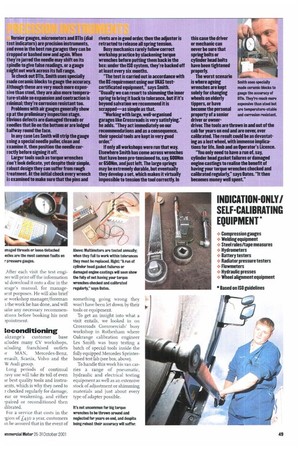Vernier gauges, micrometers and Ms (dial I est indicators) are
Page 49

If you've noticed an error in this article please click here to report it so we can fix it.
precision instruments, ind even in the best run garages they can he E. rapped or bashed now and again. When Ney're jarred the needle may shift on its s pindle to give false readings, or a gauge II right not work across its full range.
To check out Oils, Smith uses specially r lade ceramic blocks to gauge the accuracy. Although these are very much more expen s ive than steel, they are also more tempera t ire-stable so expansion and contraction is e Animal; they're corrosion resistant too. Problems with air gauges generally show pat the preliminary inspection stage. bvious defects are damaged threads or r eedies that lie on the bottom or are lodged &way round the face.
In any case Les Smith will strip the gauge r singe special needle puller, clean and c xamine it, then position the needle corr ectly before signing it off.
Larger tools such as torque wrenches on't look delicate, yet despite their simple, obust design they can suffer from rough treatment. At the initial check every wrench i; examined to make sure that the pins and
rivets are in good order, then the adjuster is retracted to release all spring tension.
Busy mechanics rarely follow correct workshop practice by slackening torque wrenches before putting them back in the box: under the ISO system. they're backed off at least every six months.
"The test is carried out in accordance with the BS requirement using our LIRAS testcertificated equipment," says Smith. "Usually we can resort to shimming the inner spring to bring it back to tolerance, but it it's beyond salvation we recommend it is scrapped—as simple as that.
"Working with large, well-organised garages like Crossroads is very satisfying," he adds. "They act immediately on our recommendations and as a consequence, their special tools are kept in very good order.," If only all workshops were run that way. Elsewhere Smith has come across wrenches that have been pre-tensioned to, say, 600Nm or 650Nm, and just left. The large springs may be extremely durable, but eventually they develop a set, which makes it virtually impossible to tension the tool correctly. In this case the driver or mechanic can never be sure that spring bolts or cylinder head bolts have been tightened properly.
The worst scenario is where ageing wrenches are kept solely for changing wheels on elderly tippers, or have become the personal property of a senior driver or owner driver. The tools are thrown in and out of the cab for years on end and are never, ever calibrated. The result could be as devastatingas a lost wheel, with immense implications for life, limb and an Operator's Licence.
"You only needle have a run of, say, cylinder head gasket failures or damaged engine castings to realise the benefit of having your torque wrenches checked and calibrated regularly," says Oates. "It then becomes money well spent."
Smith uses specially made ceramic blocks to gauge the accuracy of UN. They're much more expensive than steel but are temperature-stable and corrosion resistant












































































































































